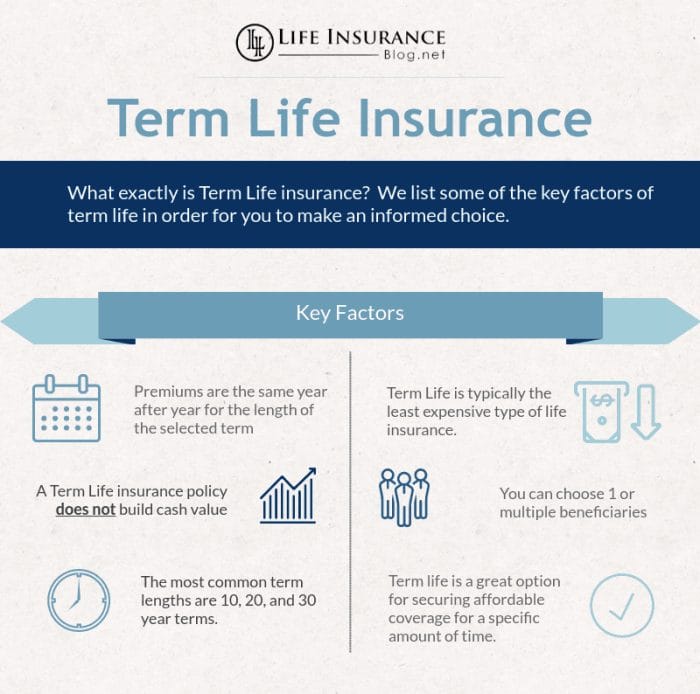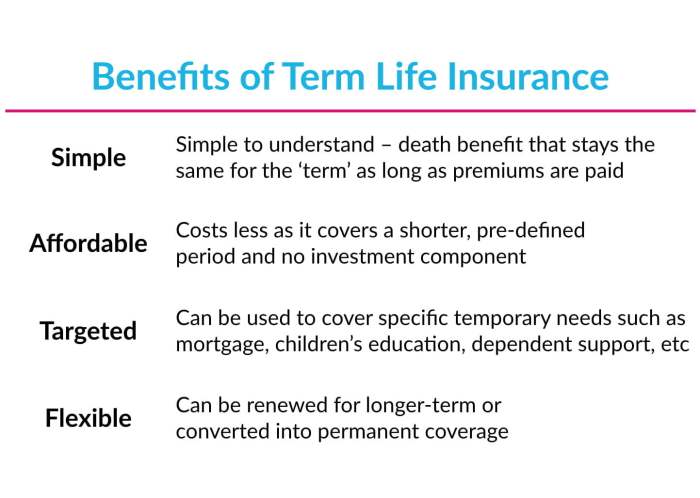In the realm of financial planning, securing the future of your loved ones is paramount. Term life insurance emerges as a cornerstone of this endeavor, offering a safety net that shields them from financial hardships in the event of your untimely demise.
Navigating the intricacies of term life insurance can be daunting, but with the right guidance, you can make informed decisions that safeguard your family’s well-being.
This comprehensive guide delves into the intricacies of selecting the right term life insurance policy, empowering you with the knowledge to make confident choices. We’ll explore crucial factors to consider, from determining your coverage needs and understanding different types of policies to evaluating insurance providers and comprehending policy features.
Whether you’re a seasoned investor or a novice in the world of insurance, this guide will equip you with the insights necessary to secure your family’s financial future.
Determining Your Needs

Selecting the right term life insurance policy requires careful consideration of your financial obligations and future goals. Follow these steps to determine the appropriate amount of coverage:
Assess Your Financial Obligations
Begin by assessing your current financial obligations, including mortgages, debts, and ongoing expenses. Consider your family’s standard of living and any special needs or obligations you have.
Calculate Your Human Life Value
Estimate your human life value by multiplying your annual income by the number of years you expect to work. This provides an approximate value of the income you would have earned had you lived.
Consider Your Family’s Future Needs
Factor in your family’s future needs, such as education expenses for children, spouse’s income replacement, and retirement planning. Ensure that the coverage amount is sufficient to meet these expenses.
Review Your Assets and Savings
Take stock of your current assets and savings, including investments, retirement accounts, and any life insurance policies you already have. Deduct these assets from the calculated coverage amount to determine the additional coverage you need.
Consider Your Age, Health, and Occupation
Your age, health status, and occupation can affect your life insurance premiums. Younger and healthier individuals typically pay lower premiums compared to older or high-risk individuals.
Consult a Financial Advisor
Consider consulting a qualified financial advisor who can help you analyze your financial situation and recommend an appropriate term life insurance policy that aligns with your specific needs and goals.
Understanding Different Types of Term Life Insurance

Understanding the different types of term life insurance policies is crucial for making an informed decision. Let’s explore the key differences between level term life insurance and decreasing term life insurance, delve into the concept of riders, and discuss the significance of considering the term length when selecting a policy.
Level Term Life Insurance
Level term life insurance provides a fixed death benefit throughout the policy’s term. Regardless of your age or health status, the coverage amount remains the same. This type of policy offers stability and predictability in terms of premiums and coverage.
However, premiums may be higher than decreasing term life insurance, especially as you age.
Decreasing Term Life Insurance
Decreasing term life insurance provides a death benefit that gradually decreases over the policy’s term. This type of policy is often used to cover specific financial obligations, such as a mortgage or car loan, that decrease over time. Premiums are typically lower than level term life insurance, but the coverage amount also decreases, potentially leaving you with inadequate coverage later in life.
Term Life Insurance Riders
Term life insurance riders are optional add-ons that can enhance the policy’s coverage and benefits. Common riders include:
- Waiver of Premium Rider: This rider waives your premium payments if you become disabled and unable to work.
- Accelerated Death Benefit Rider: This rider allows you to access a portion of your death benefit while you are still living if you are diagnosed with a terminal illness.
- Children’s Term Rider: This rider provides coverage for your children, typically until they reach adulthood.
Considering the Term Length
The term length is the period during which the policy provides coverage. Common term lengths include 10, 20, and 30 years. Choosing the right term length depends on your individual circumstances and financial goals. Consider factors such as your age, income, family responsibilities, and long-term financial plans when determining the appropriate term length.
Evaluating Insurance Providers

Researching and comparing different life insurance companies is crucial for selecting the right term life insurance policy. Consider factors like financial stability, customer service, and claim settlement history. Working with an experienced and reputable insurance agent can also provide valuable insights and guidance.
Financial Stability
Review the company’s financial strength ratings from independent agencies like A.M. Best, Moody’s, or Standard & Poor’s. Higher ratings indicate a strong ability to meet future obligations.
Customer Service
Look for companies with a track record of excellent customer service. Read online reviews and ratings to understand the company’s responsiveness, efficiency, and helpfulness in handling customer inquiries and claims.
Claim Settlement History
Research the company’s claim settlement history. Check for a high percentage of claims paid promptly and without hassle. A good claim settlement ratio reflects the company’s commitment to honoring its obligations.
Benefits of Working with an Experienced Agent
An experienced and reputable insurance agent can provide valuable insights and guidance throughout the process. They can help you understand different policies, compare quotes, and navigate the application process.
Understanding Policy Features and Benefits

Before purchasing term life insurance, thoroughly review the policy’s terms and conditions to understand its features and benefits. These policies often include various features that enhance coverage and provide additional benefits.
Common Features and Benefits
- Death Benefit: The primary benefit of term life insurance is the death benefit, a lump-sum payment made to the policy’s beneficiaries upon the insured’s death. The amount of the death benefit is determined by the policy’s face value.
- Cash Value: Some term life insurance policies accumulate a cash value over time. This cash value can be borrowed against or withdrawn for various purposes, such as retirement or educational expenses.
- Accelerated Death Benefit: This rider allows the policyholder to access a portion of the death benefit while still living if they are diagnosed with a terminal illness.
Riders
Riders are optional add-ons that can be purchased to enhance the policy’s coverage and benefits. Common riders include:
- Waiver of Premium Rider: This rider waives the premium payments if the policyholder becomes disabled and unable to work.
- Accidental Death Benefit Rider: This rider provides an additional death benefit if the policyholder dies due to an accident.
- Child Rider: This rider provides coverage for the policyholder’s children, typically until they reach a certain age or become financially independent.
Carefully consider the features and benefits offered by different term life insurance policies to choose the one that best meets your needs and budget.
Considering Your Health and Lifestyle

Your health and lifestyle can significantly impact your life insurance premiums. Understanding this relationship can help you make informed decisions about your coverage and potentially lower your costs.
Maintaining a Healthy Lifestyle:
- Exercise Regularly: Regular physical activity can reduce your risk of chronic diseases, such as heart disease, stroke, and type 2 diabetes, which can lead to lower premiums.
- Eat a Healthy Diet: A balanced diet rich in fruits, vegetables, and whole grains can contribute to overall well-being and potentially lower your risk of certain health conditions.
- Avoid Tobacco: Smoking and tobacco use are significant risk factors for various health problems. Avoiding tobacco can significantly improve your health and potentially reduce your life insurance premiums.
- Manage Stress: Chronic stress can negatively impact your health and increase your risk of certain diseases. Practicing stress management techniques, such as yoga, meditation, or spending time in nature, can promote overall well-being and potentially lower your premiums.
- Get Regular Checkups: Regular medical checkups can help identify and manage health conditions early, potentially reducing the severity and impact on your life insurance premiums.
Pre-existing Medical Conditions
Pre-existing medical conditions can affect your life insurance eligibility and premiums. The impact varies depending on the condition’s severity, your age, and other factors. It’s important to disclose any pre-existing conditions accurately and honestly during the application process.
- Minor Conditions: Some minor conditions, such as well-controlled asthma or high blood pressure, may not significantly impact your premiums or eligibility.
- Serious Conditions: More severe conditions, such as cancer, heart disease, or stroke, may lead to higher premiums or even denial of coverage. However, the specific impact depends on the individual’s circumstances and the insurance company’s underwriting guidelines.
- Underwriting Process: Insurance companies assess the risk associated with each applicant based on their medical history, lifestyle, and other factors. This process, known as underwriting, determines the premium rates and coverage terms.
Budgeting for Life Insurance Premiums

Planning for life insurance premiums requires careful consideration of your financial obligations and long-term goals. It’s essential to create a budget that accommodates these premiums while balancing other financial priorities.
Strategies for Budgeting
- Review your income and expenses: Assess your current financial situation to understand how much you can allocate towards life insurance premiums. Consider your monthly income, fixed expenses (like rent or mortgage), variable expenses (like groceries or entertainment), and any debts.
- Prioritize your financial goals: Determine your short-term and long-term financial goals, such as buying a home, saving for retirement, or funding your child’s education. Life insurance should be a part of this overall financial plan.
- Compare insurance quotes: Obtain quotes from multiple insurance providers to compare premiums and coverage options. Consider factors like your age, health, and the amount of coverage you need. This comparison can help you find the best value for your money.
- Choose an affordable premium payment option: Insurance companies offer various premium payment options, such as monthly, quarterly, or annually. Select the option that aligns with your budget and cash flow. Keep in mind that paying premiums more frequently may result in lower overall costs.
Understanding Premium Payment Options
Life insurance premiums can be paid in different ways, each with its own implications:
- Monthly premiums: Paying premiums monthly is the most common option. It allows you to spread the cost over time and may be easier to manage for those on a tight budget. However, monthly payments may result in higher overall costs due to interest charges.
- Quarterly premiums: Paying premiums quarterly is less frequent than monthly payments, but it can still provide some flexibility. It may also lead to slightly lower overall costs compared to monthly payments.
- Annual premiums: Paying premiums annually is the least frequent option. It requires a larger upfront payment but can result in significant savings in the long run. Annual payments typically incur lower interest charges and may also qualify for discounts from insurance providers.
Considering Potential Premium Increases
Life insurance premiums can increase over time due to factors such as age, changes in health, or changes in the insurance policy. It’s important to consider these potential increases when budgeting for premiums.
- Review your policy regularly: Periodically review your life insurance policy to ensure that it still meets your needs and that you can afford the premiums. Consider adjusting your coverage amount or premium payment option if necessary.
- Plan for potential premium increases: When budgeting for life insurance premiums, set aside a contingency fund to cover potential premium increases in the future. This fund can help you avoid financial strain if your premiums rise unexpectedly.
Preparing for the Application Process

Applying for life insurance involves gathering necessary documents, providing accurate information, and undergoing medical exams. Preparing thoroughly enhances the efficiency of the process and ensures a smooth underwriting experience.
Checklist of Required Documents and Information
Before starting the application, gather the following documents and information:
- Personal identification documents: Government-issued photo ID (passport, driver’s license), Social Security number.
- Proof of income: Recent pay stubs, W-2 forms, tax returns.
- Medical history: List of current and past medical conditions, medications, and surgeries.
- Beneficiary information: Name, date of birth, and contact details of the person(s) who will receive the death benefit.
Importance of Honesty and Accuracy
Providing honest and accurate information on the application is crucial. Misrepresentation or omission of facts can lead to policy denial or reduced benefits. Insurance companies rely on this information to assess the risk associated with insuring you and determine your premium rate.
Medical Exams and Their Impact
Medical exams are often required as part of the underwriting process. These exams help the insurance company assess your overall health and identify any potential health risks that may affect your life expectancy. Common tests include blood pressure, cholesterol, and urine analysis.
The results of the medical exam can impact your premium rate and the amount of coverage you are eligible for.
Reviewing and Understanding the Policy
Thoroughly reviewing the policy document before signing is essential for ensuring you comprehend your rights, obligations, and the extent of coverage provided.
Scrutinize the policy’s key provisions, including:
- Death Benefit: Confirm the amount of coverage you’re entitled to upon your demise. This sum should align with your financial obligations and goals.
- Premium Payment Schedule: Understand the frequency of premium payments (monthly, quarterly, annually) and the due dates. Consider setting up automatic payments to avoid missing deadlines.
- Policy Exclusions: Be aware of any circumstances or activities that could invalidate your coverage. Common exclusions include death resulting from hazardous activities, suicide within a specific period, or engaging in illegal acts.
Furthermore, familiarize yourself with the grace period, which typically ranges from 10 to 31 days. During this period, you can make overdue premium payments without lapsing your policy. However, coverage may be suspended until the premium is paid.
Maintaining and Updating Your Policy
Ensuring your life insurance policy remains relevant and aligned with your evolving needs and circumstances is crucial. Regular reviews and potential adjustments are essential to maintain adequate coverage. Failure to do so could result in insufficient protection or even policy lapse, leaving your loved ones financially vulnerable.
Reviewing Your Policy Regularly
Life circumstances are dynamic, and your insurance coverage should reflect these changes. Periodically reviewing your policy ensures it continues to meet your evolving needs. Consider reviewing your policy annually or whenever significant life events occur, such as marriage, birth of a child, or a change in employment or income.
Considering Long-Term Financial Planning

Life insurance is an integral component of a comprehensive financial plan, providing a safety net for your loved ones and ensuring their financial well-being in the event of your untimely demise. It complements other financial strategies, such as retirement savings and estate planning, by safeguarding your family’s financial future and achieving your long-term financial goals.
Integrating Life Insurance into Your Financial Goals
- Protect Income and Provide Financial Security: Life insurance ensures that your family can maintain their standard of living and meet ongoing expenses, such as mortgage payments, education costs, and daily living expenses, in the event of your passing.
- Preserve Assets and Investments: Life insurance can help preserve your assets and investments by providing a lump sum payout that can be used to cover outstanding debts, taxes, or other financial obligations, preventing the depletion of your estate.
- Fund Long-Term Goals: Life insurance can be used as a vehicle to fund long-term financial goals, such as your children’s education, retirement, or a down payment on a house. By incorporating life insurance into your financial plan, you can ensure that these goals are not derailed by unforeseen circumstances.
- Estate Planning: Life insurance can be a valuable tool for estate planning, allowing you to distribute your assets according to your wishes and minimizing the tax burden on your beneficiaries. It can also help ensure that your estate remains intact and is not subject to probate, simplifying the transfer of assets to your loved ones.
Last Point
Choosing the right term life insurance policy is a crucial step in safeguarding your family’s financial well-being. By carefully assessing your needs, understanding different types of policies, evaluating insurance providers, and comprehending policy features, you can make informed decisions that provide peace of mind and protect your loved ones from life’s uncertainties.
Remember, life insurance is not just a financial transaction; it’s an act of love and responsibility that ensures your family’s financial stability, no matter what life throws their way.
FAQ Summary
What is the significance of determining my life insurance coverage needs?
Assessing your coverage needs is essential to ensure adequate protection for your family. Consider your income, debts, future goals, and family situation to determine the appropriate amount of coverage.
What are the key differences between level term life insurance and decreasing term life insurance?
Level term life insurance provides a fixed death benefit throughout the policy term, while decreasing term life insurance offers a death benefit that decreases over time. Choose the type that best aligns with your changing needs and financial goals.
How can I evaluate the financial stability and reputation of an insurance provider?
Research the company’s financial ratings, customer reviews, and claim settlement history. Consider working with an experienced and reputable insurance agent who can provide valuable insights and guidance.
What are some common features and benefits included in term life insurance policies?
Term life insurance policies typically include a death benefit, cash value (in some policies), and accelerated death benefit. Riders can be added to enhance coverage and provide additional benefits, such as coverage for critical illnesses or accidental death.
How can I maintain and update my life insurance policy as my needs change?
Regularly review your policy to ensure it still meets your coverage needs. Consider increasing your coverage as your income and responsibilities grow. Notify your insurance provider of any significant life changes, such as marriage, birth of a child, or a career change.



